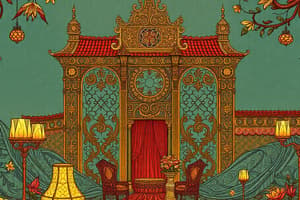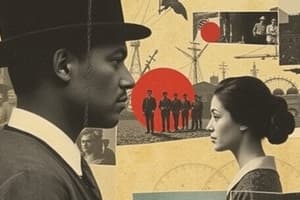Podcast
Questions and Answers
Which of the following best describes the relationship between culture and society, according to Anthony Giddens?
Which of the following best describes the relationship between culture and society, according to Anthony Giddens?
- Society dictates culture, determining beliefs, values, and norms without cultural input.
- Culture is a subset of society, focusing only on artistic expressions.
- Culture and society are independent entities with no mutual influence.
- Culture and society are interdependent, with culture shaping societal functions and values, and society providing the structure for cultural expression. (correct)
Beliefs are defined as convictions held with concrete evidence, universally accepted across different societies and time periods.
Beliefs are defined as convictions held with concrete evidence, universally accepted across different societies and time periods.
False (B)
What role does language play in the cohesion of a society?
What role does language play in the cohesion of a society?
Language is essential for communication and societal cohesion.
___________ are widely accepted beliefs about what is desirable, influencing the norms and rules of a society.
___________ are widely accepted beliefs about what is desirable, influencing the norms and rules of a society.
Match the types of culture with their descriptions:
Match the types of culture with their descriptions:
Which of the following examples illustrates a symbolic cultural artefact that represents historical and political struggles?
Which of the following examples illustrates a symbolic cultural artefact that represents historical and political struggles?
Norms are rules governing behavior that remain consistent across all contexts and cultures.
Norms are rules governing behavior that remain consistent across all contexts and cultures.
What is the difference between mores and laws?
What is the difference between mores and laws?
Expected behavior for specific social positions, such as the professionalism expected of doctors, are known as ___________.
Expected behavior for specific social positions, such as the professionalism expected of doctors, are known as ___________.
Which of the following is an example of a custom that is passed down through generations?
Which of the following is an example of a custom that is passed down through generations?
Flashcards
Definition of Culture
Definition of Culture
The complete way of life of a society, including knowledge, beliefs, language, values, and customs.
Culture vs. Society
Culture vs. Society
Culture enables self-consciousness and identity, while society is a structured community creating institutions.
Beliefs
Beliefs
Strongly held convictions, often without concrete evidence, that shape societal values and actions.
Language
Language
Signup and view all the flashcards
Symbolic Cultural Artifacts
Symbolic Cultural Artifacts
Signup and view all the flashcards
High Culture
High Culture
Signup and view all the flashcards
Mass/Popular Culture
Mass/Popular Culture
Signup and view all the flashcards
Folk Culture
Folk Culture
Signup and view all the flashcards
Values
Values
Signup and view all the flashcards
Norms
Norms
Signup and view all the flashcards
Study Notes
- Culture is a society's entire way of life, encompassing knowledge, beliefs, language, values, norms, customs, traditions, mores, cuisine, arts, and music.
- Culture and society are interdependent; culture fosters self-consciousness and identity.
Culture vs. Society
- Society is a structured community where individuals interact and create institutions like family, education, government, religion, and media.
- Culture shapes societal functions and values.
Key Elements of Culture
- Beliefs are strong convictions held without evidence and vary across time and societies.
Beliefs
- The divine right of kings contrasts with republicanism as an example of varying beliefs.
- Some monarchies still uphold traditional beliefs.
- The American Dream, as defined in 1931, is the belief in opportunity regardless of social class.
- Western societies value reason, while Middle Eastern and Asian societies may prioritize hierarchy and authoritarianism.
Language
- Language is essential for communication and societal cohesion.
- As an example, Hindi unifies India.
Symbolic Cultural Artefacts
- Symbolic cultural artifacts include flags, dress, monuments, and cultural products like music, cuisine, and sports.
- Sports, like cricket, symbolize historical and political struggles.
Types of Culture
High Culture
- High culture is associated with the elite, and includes theatre, opera, ballet, and classical music.
- Shakespearean plays in English-speaking countries and Kabuki in Japan are examples of high culture.
Mass/Popular Culture
- Mass/popular culture consists of mass-produced entertainment like TV, films, pop music, and social media.
- Mass/popular culture is often criticized for being superficial and sensationalist.
Folk Culture
- Folk culture is the culture of ordinary people, often in pre-industrial societies.
- It is passed down through generations and includes folk songs, dances, and myths.
- Bollywood films incorporating Hindu mythology are an example.
Values
- Values are widely accepted beliefs about what is desirable.
- Universal values include human life, compassion, and family life.
- Relative values vary by society and time period.
- American values include patriotism and gun rights.
- Asian value systems prioritize community over individual rights.
Norms
- Norms are rules governing behavior in specific contexts.
- Western privacy norms contrast with Trinidadian social openness.
- American handshakes differ from Arab expressive gestures.
- Respectful kneeling in African cultures contrasts with gender equality concerns.
- Muslim norms on modesty include the hijab, niqab, and burka, as well as family respect.
- Cultural taboos include cannibalism, considered sacred by the Korowai tribe of Papua New Guinea.
Roles
- Roles are expected behaviors for specific social positions.
- Doctors are expected to show professionalism and confidentiality.
- Gender roles involve distinct societal expectations for men and women.
Customs
- Customs are traditional norms passed through generations.
- Examples include Ramadan in Islam, and Diwali in Hinduism, Sikhism, and Jainism.
Social Mores and Laws
- Mores are strongly held moral values, often concerning behavior and sexuality.
- Deviance is a violation of norms, and can be informal or legal.
- Laws are formalized norms with legal consequences.
- Human life protection laws criminalize murder, negligence, and abuse.
Studying That Suits You
Use AI to generate personalized quizzes and flashcards to suit your learning preferences.




